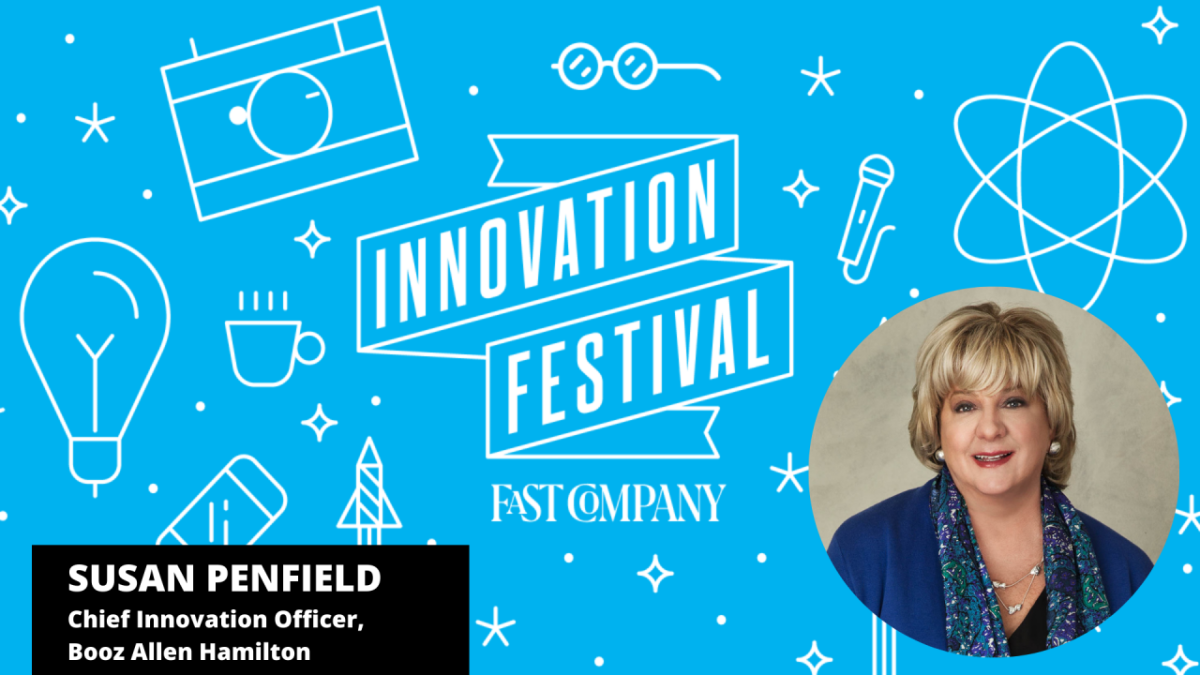Booz Allen's Susan Penfield On What's Next in Government Innovation

In October, Booz Allen served as the Presenting Sponsor of the first-ever virtual Fast Company Innovation Festival, with firm leaders joining compelling panel discussions on innovation, cybersecurity, the space race, and the future of recreation. Join us as we recap these timely conversations in a dedicated series of posts.
Federal government programs have catalyzed breakthroughs from the internet to GPS to space exploration, and groundbreaking progress continues in our current environment—yet too often there is a misperception that big-time, game-changing innovation belongs exclusively to the private sector.
That’s not true, says Booz Allen Executive Vice President Susan Penfield, who joined Rhode Island Governor Gina Raimondo and Google co-founder Eric Schmidt at the 2020 Fast Company Innovation Festival for a thought-provoking conversation about innovation in government, including opportunities, obstacles, and what’s needed to move forward.
Building an innovation culture
“There’s amazing work being done [in government] every day,” said Penfield, citing examples from the Joint Artificial Intelligence Center at the Department of Defense, launched in only 18 months, to healthcare agencies “innovating on the fly” in areas like COVID-19 contact tracing and disease modeling.
Even so, innovation is not always easy in a process-intensive, often risk-averse government environment. How can agency leaders build and nurture an innovation culture?
Start with education and understanding, Penfield advised. For example, Booz Allen has been working with the not-for-profit Partnership for Public Service to promote technical literacy in areas like the cloud, AI, and cybersecurity and partnering with Nvidia to deliver AI training to more than 1,500 government leaders, helping government clients get the most from new technology so they can use it to create more effective missions.
“Building a knowledge base creates a new level of excitement for government leaders when they get their hands on these new technologies and tools,” said Penfield.
Exploring new approaches to partnerships and procurement
Lengthy procurement processes mean that it can take several months or longer for government agencies to acquire new technologies—a timeframe that’s not conducive to today’s rapid development cycles or innovation in general.
Federal leaders can catch up by being creative, Penfield said. She highlighted Recreation.gov, an interagency coalition of 12 federal partners including the Forest Service, Army Corps of Engineers, and the National Park Service, as an example. Recreation.gov was relaunched in 2018 as an investment for Booz Allen—designed collaboratively with participating agencies, but at no cost to the federal government. Instead of a traditional cost structure, the unique contractual agreement is a transaction-based fee model that lets the government and Booz Allen share in risk, reward, results, and impact.
“Innovation from the private sector compelled government to innovate in the contracting space and pay us in a different way,” she said.
Penfield also cited procurement methods like Other Transaction Authority (OTA) contracts, which are designed for certain prototypes, research, and production projects. These can be useful for bringing in initial capabilities, laying the foundation for broader systems, and showing an organization what technology could bring to its challenges and mission.
“It’s been a really great tool for our clients to get innovation into their missions much more quickly,” said Penfield.
Applying a mission focus to incentives and talent
In the private sector, incentives for innovation are often quite clear: If you’re slow to move, you lose clients, revenues, and competitive advantage. So how does one incentivize innovation in the government space?
“It’s about mission effectiveness,” Penfield explained. She talked about a project she was involved with 10 years ago for the Centers for Disease Control (CDC). The goal was to streamline a complex supply chain for a children’s vaccine program. The initiative generated considerable savings but even more importantly furthered the program’s mission: safer, more effective vaccine delivery.
Booz Allen actively hires professionals with a government background to serve as “mission translators,” Penfield said. Once onboard, these employees receive training on in-demand skillsets like data science plus guidance on new ways of working.
“Our culture is very collaborative and functions like the tech sector,” she said. “We mentor everyone who comes in the door to help them understand our culture and get up to speed fairly quickly. It’s all part of the firm’s goal to ensure the right talent at the right time to serve our government clients.”
Watch the full Fast Company Innovation Festival panel discussion and learn more about innovation at Booz Allen

